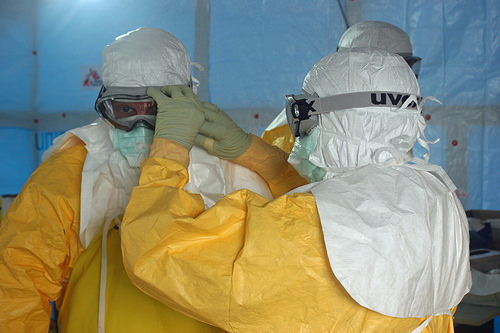UN Ebola Chief asks for $1B More
David Nabarro, the head of the United Nations’ efforts to stop the deadliest-ever Ebola outbreak, said UN agencies need another $1 billion to continue their battle against the potentially deadly viral infection.
Nabarro said an overall total of $4 billion would allow relief agencies to continue their work in the hardest-hit West African nations of Liberia, Guinea and Sierra Leone. Additional funds also would allow Ebola experts to track down the remaining cases of infection.
Tracing those cases could require as many as “1,000 epidemiologists, since there are still around 50 micro-outbreaks in the region,” according to Ben Hirschler’s Jan. 21 Reuters report.
The UN has received about $1 billion in aid, or roughly 1/3 of the amount it requested last year. Should it be donated, Nabarro’s request would equal previously realized relief funds.
The World Health Organization said the Ebola outbreak has killed almost 8,600 people, mostly in Liberia, Guinea and Sierra Leone. The rate of infection is slowing in many areas, but experts said it would be difficult to track down the remaining Ebola cases to prevent another flare-up or outbreak.
Isolating and treating Ebola patients is made more effective with BLU-MED Response Systems Medical Shelters. These highly portable fabric tension structures have been used in the fight against Ebola in Liberia, and BLU-MED maintains a stockpile of mobile field hospitals and Ebola isolation units to ensure rapid deployment to anywhere in the world.
Liberia, Guinea and Sierra Leone have seen drops in the number of reported Ebola cases in recent weeks. With the Ebola outbreak appearing to wane, schools reopened in Guinea as Mali joined Nigeria and Senegal as being declared Ebola-free by the WHO.
Tom Frieden, chief of the Centers for Disease Control and Prevention, said he is “confident” the outbreak can be ended, provided “nothing unexpected happens,” according to Erin Conway-Smith’s Jan. 21 article on the USA Today website.
However, Frieden added that the biggest health risk is if Ebola continues to spread at a low rate, allowing it to flare up again.
“We have to get to zero and then stay at zero and that’s going to require monitoring, surveillance,” Frieden said.
Researchers have identified a characteristic found in Ebola that could complicate efforts to eradicate the virus, at least for now. Ebola can mutate over time, which could mean that vaccines currently being developed might be obsolete by the time they hit the market, according to a Jan. 20 article posted on Yahoo’s health page.
Another group of researchers hope that genetically modified cows will prove to be an important resource in creating Ebola cures. The cows have been genetically engineered with human DNA, vaccinated against Ebola, and are incubating antibodies against the virus. Scientists hope to harvest the hybrid cows’ blood plasma to treat people with Ebola. Each modified cow can produce between 30 and 60 liters of blood per month, enough to create 500 to 1,000 doses of Ebola treatments every four weeks.
